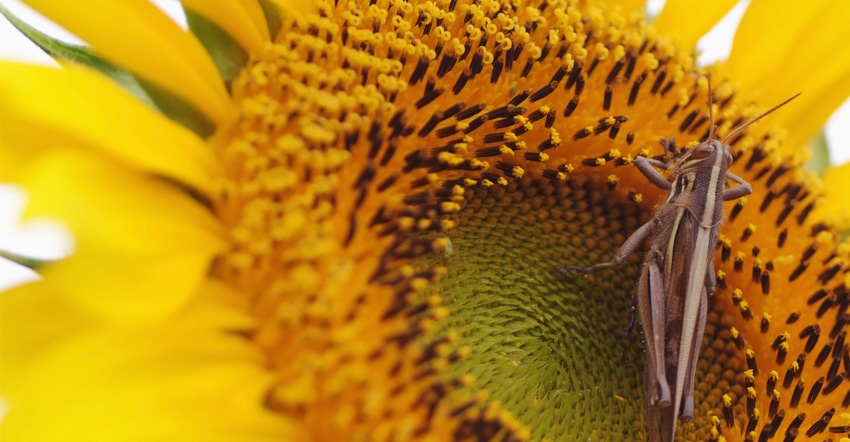July 29, 2021

As the growing season continues, South Dakota producers may be noticing an increase of pests affecting their sunflower fields. The main pests being seen in fields are grasshoppers, and three types of cutworms. South Dakota State University Extension shares how producers can look for and manage these pests.
Grasshoppers
Grasslands in South Dakota will continue to dry down as summer progresses. However, this normal trend has been accelerated by the ongoing drought across much of the state. With their grassland food sources being depleted earlier than usual, grasshoppers are moving into nearby crops in search of green vegetation.
In parts of western South Dakota, grasshopper nymphs have already been observed in sunflower fields feeding on the young plants. These grasshopper populations will be a rising concern as they develop into adults and their appetites increase. Therefore, it is important to begin monitoring sunflower fields now to ensure that grasshopper populations do not reduce yields.
The best way to scout for grasshoppers in sunflower is to visually estimate the number of grasshoppers present in 1 square yard and repeat the process for several areas of the field. Field margins can be scouted using a sweep net. Thirty to 45 nymphs or eight to 14 adults warrant an insecticide application to reduce the populations.
Defoliation estimates can also be used to determine if treatment is necessary. During the R1 to R5 stages, treatment should be considered at an average of 20% defoliation throughout the field. If grasshoppers are observed feeding on the sunflower heads later in the season, populations are likely above threshold. This type of feeding will greatly reduce sunflower yield. When applying insecticides to manage grasshopper populations, use the highest labeled rate for the selected products.
Cutworms
There are three species of cutworms that are reported as pests of sunflowers. These include:
dingy cutworm
redbacked cutworm
darksided cutworm
Dingy cutworms are considered an early-season cutworm, because they overwinter as caterpillars in the soil. They are normally done feeding by mid-June. The redbacked and darksided cutworms are late-season cutworms, with late being a relative term. These two species overwinter as eggs, and after hatching in the spring, they will feed until the end of June. It is likely that the observations of cut plants were due to one of these species.
All of the cutworm species listed are nocturnal feeders that hide in the soil during the day. These cutworms can be observed by using a hand trowel and digging in the soil near plants that show signs of defoliation or cutting.
Cutworms may also be present under plant debris that is in the field. To scout for cutworms, walk in a “W” or “Z” pattern, and examine injured plants in five locations within the pattern. At each location, use the trowel to search a 1-square-foot area within the row. Dig about 2 inches deep and carefully sift through the soil when looking for caterpillars. In no-till fields, the caterpillars will often hide under crop residue.
Since it is late in the season, treating fields for cutworms is not recommended. If this issue had been observed earlier in June, insecticide management for cutworms could be considered.
The threshold for cutworms in sunflowers is an average of 25% to 30% cut plants from the scouted areas of the field. For cutworms, management after emergence can be achieved through the use of foliar insecticides.
For more information, visit SDSU Extension’s Pest Management Guides.
Source: South Dakota State University Extension, which is responsible for the information provided and is wholly owned by the source. Informa Business Media and its subsidiaries aren't responsible for any of the content contained in this information asset.
Read more about:
SunflowersYou May Also Like




